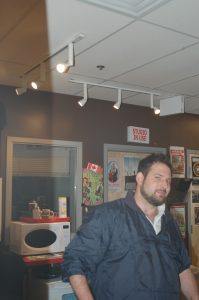Date Posted: June 26, 2011
Print Edition: June 24, 2011
By Aaron Levy (CIVL Station Manager) – Email
 Tear gas, rubber bullets, and riot police advancing on a crowd of rowdy, drunken, lawless… anarchists?
Tear gas, rubber bullets, and riot police advancing on a crowd of rowdy, drunken, lawless… anarchists?
Canadians have seen it happen twice this year; burning, upturned automobiles, and businesses with their windows smashed out; once in relation to a major, international, political summit, and once in tribute to a similar, less widespread, less easily quashed riot that took place 17 years ago. One instance was certainly the result of a strong and organized faction of anarchists, but the other? Not so much.
It’s true that many of the protestors and mischief makers in Toronto for the G20 summit last May were self proclaimed anarchists, but that’s not to say that everyone committing mayhem throughout downtown Toronto was one.
Similarly, there might have been some anarchists in the mix of the Vancouver riots following game 7 of the 2010-11 Stanley Cup Finals. Who’s to say there weren’t?
But the images we’ve seen where throngs of hockey fans, Vancouverites, and the like systematically demolished department stores, coffee shops, and tuxedo proprietors, did not contain any evidence that so-called anarchists were responsible.
The newscasts we’ve seen have, however, routinely referred to the looters and vandals as anarchists. The rhetoric used therein displays a dysfunctional, distorted view of who anarchists are, what they do, and what happened both in Toronto and Vancouver during their respective riots.
Anarchy is often defined as a lack of structural order or singular leadership within a state. It is often discussed in the context of chaos and disorder, such that a mess or disorganized situation may be described as anarchic.
For an individual, however, to be referred to as an anarchist, is it sufficient to say that said person participates in a state of anarchy? I’d say not, but this is the attribution that’s been made unto people who participated in the recent Vancouver riots. Individual citizens, who, for at least a time, decided to engage in various acts of civil disobedience, were described as anarchists: “Immediately following the Canucks’ Stanley Cup loss at the hands of the Boston Bruins, anarchists began to flip cars over and light them on fire.” It certainly makes them a party to an anarchic series of events, but finishing my dinner quickly doesn’t make me a competitive eater.
For an individual to in actuality be an anarchist, however, one must actively internalize and believe in the main tenets of anarchy itself; that is to say that such a person may acknowledge that absolute power corrupts absolutely; perhaps they believe that hegemony and the rule of law only function to serve those wealthy and privileged enough to have a hand in determining how and when it will be carried out and to what extent; regardless of why, an anarchist must actively believe in the benefits of eventual dissolution of what we recognize as certain facets of our democratic government, whether or not they actively work to make that happen or agree on how to do it.
To be an anarchist one must, at the very least, understand and agree with the idea of anarchy as a political structure. Participating in destruction for no apparent reason does not qualify.
At the risk of being subjective and arbitrary, most anarchists aren’t in favour of chaos and disorder as a rule, they simply prefer a governance model of consensual decision making, where the top down functions of democracy and bureaucracy are liquidated and replaced by working groups and collaborative syndicalism.
Sure, there are some anarchists that just want every man, woman, and child for themselves, but those aren’t the ones that organize and protest. They likely do riot, but it’s a far cry from the Black Block anarchists that were attributed with organizing and carrying out the protests during the G20 riots. Despite these nuances, and fundamental distinctions between the Vancouver riots and the characterization of those involved as anarchists, the media has paid no attention to the divide.
So, while it’s fair to say that downtown Vancouver was beholden to a lawless mob of disruptive vandals after Roberto Luongo played the worst game of his career, it’s not fair to say that ‘anarchists’ were looting, rioting, and destroying everything they could.
People were. Hockey fans were. Vancouverites were. Tourists probably were, too. But anarchists most certainly were not.
Anarchists often protest. They sometimes destroy public or private property. They are regularly involved in riots where protests are being suppressed by law enforcement.
Anarchists do not riot over the loss of a hockey game, and mainstream television newscasters and writers need to realize this. I hope you already do.


